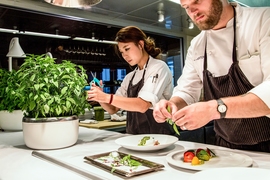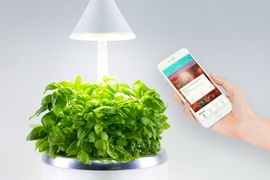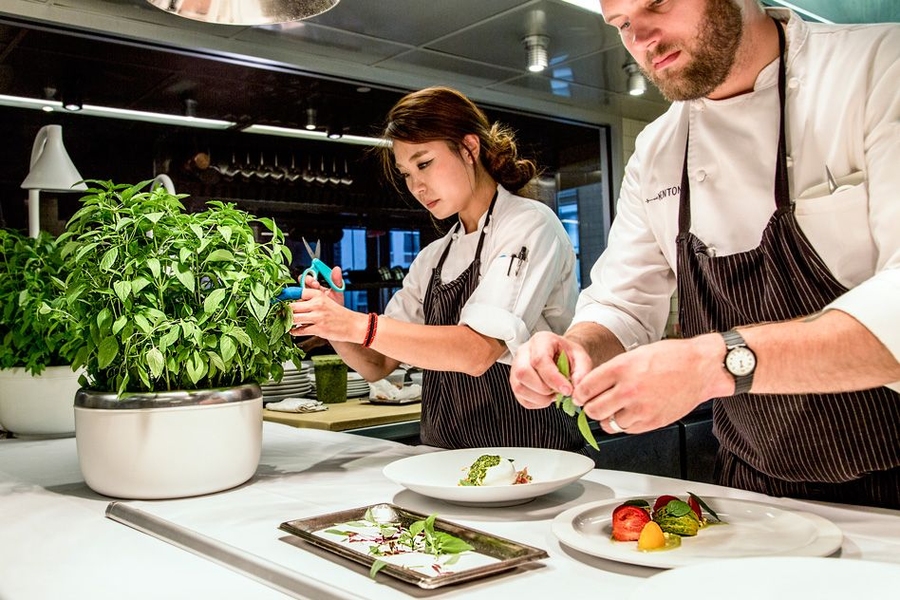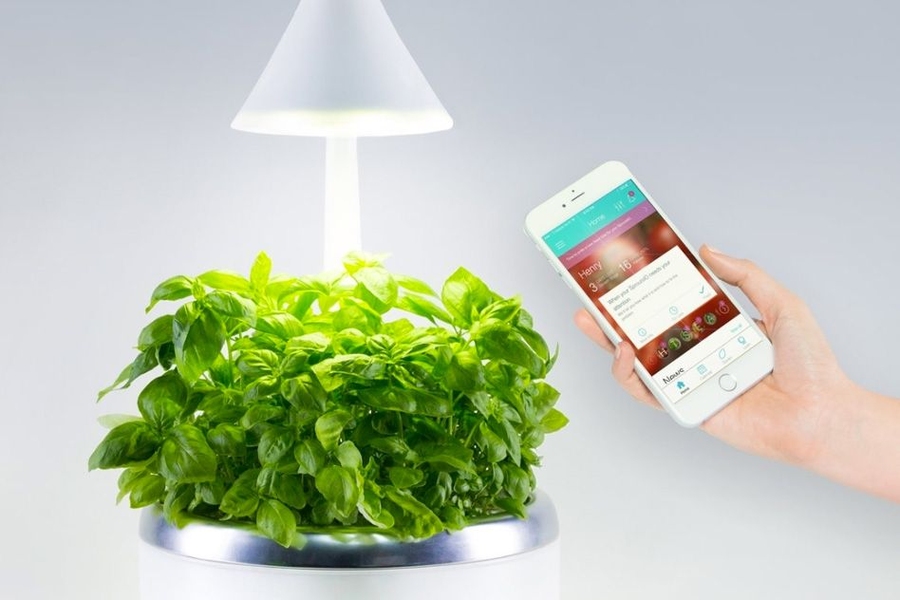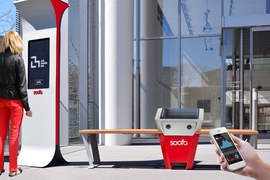MIT Media Lab alumna Jennifer Broutin Farah SM ’13, CEO and co-founder of SproutsIO, has spent nearly a decade innovating in urban farming, designing small- and large-scale gardening systems that let anyone grow food, anywhere, at any time.
All this work will soon culminate with the commercial release of her startup’s smart, app-controlled microgarden that lets consumers optimize, customize, and monitor the growth of certain fruits, vegetables, and herbs year-round. Moreover, the soil-free system uses only 2 percent of the water and 40 percent of the nutrients typically used for soil-grown plants.
After piloting the system in Boston homes and restaurants, and following a successful Kickstarter campaign last fall, SproutsIO is ramping up production and hitting the shelves in a few months. Philosophically, the aim is to power a “personal produce” movement, Farah says, in which more people grow their own food, encouraging healthier eating and cutting down on waste.
“Over the last 60 years, we’ve gotten out of touch with growing our food,” Farah says. “But when you grow your own food, you care more about what happens to it. You’re not going to throw it away, you’re going to know exactly what’s going into your plants, you’re going to share your food with friends and family. It gives a new meaning to produce.”
Customized plants
Tailoring plants for taste preferences may not be well-known outside of the wine-making world, where grapes are grown under specific climatic conditions to produce specific flavors. But produce and herbs have similar peculiarities. Even within a given species or variety, individual plants can have different characteristics and growing needs.
“Most of that is dependent on the environment,” Farah says. “If you can customize the lighting, the water, and the nutrients, you can really optimize certain variations in the plants, according to how you want them to taste. SproutsIO can reproduce these specific climatic conditions to a very precise degree.”
SproutsIO consists of a growing device, which is a large basin with a curving, overhead adjustable lamp attached; a replaceable and compostable “sIO” seed refill with growing media, seeds, and nutrients, that’s dropped into the growing device; and “SproutsIOGrow” software that includes a mobile app that collects and analyzes growth data and controls the system. Currently, the system supports basil, kale, wheatgrass, arugula, eggplant, peppers, tomatoes, tea, and a variety of plants from root vegetables to fruiting plants.
The SproutsIO system has a number of innovations developed by the startup, stemming from early research at MIT. The hybrid hydroculture system, for instance, consists of “hydroponic” and “aeroponic” growing, where roots are submerged in or misted with water and nutrients. Varying the watering process optimizes water and nutrient use while supporting the growth of different plants at different phases. A tomato plant, for instance, grows large roots during the fruiting stage. The system can lift the plant up at that time to let the roots grow larger, but still deliver water and nutrients by misting.
There’s also a custom LED light that automatically adjusts, depending on need. If the device is located near a window, where sunlight is plentiful, the light will dim; if the sunlight diminishes or if the device is placed in darker areas, the light shines brighter. The system uses about half the electricity of a 60-watt incandescent light bulb.
Sensors monitor plant growth and transmit data to what Farah calls the “backbone” of the system: SproutsIOGrow. The app lets users customize their plants and monitor the plant’s growth in real-time. Depending on light and nutrients added, for instance, tomatoes can be grown to taste sweeter or more savory.
The app also provides predictive growth cycles and connects to personal activity trackers, meal planners, and calendars to help with meal scheduling. A built-in camera takes regular snapshots of growing plants for health diagnostics and to create time-lapse images for users on the app.
Growing plants in such a controlled environment boosts growth efficiency by six times and cuts the length of growth cycles by 50 percent over traditional gardening, according to the startup.
Farah says people often ask her if all the technology tends to remove people from the growing process. It’s the exact opposite, she says: “Technology creates a whole new lens on the growing process. Most of us don’t understand how plants grow because they exist on a totally different time scale. But we show people how the plants grow over time and how they react to certain changes. That’s really eye-opening.”
Shrinking greenhouses
Today’s SproutsIO system is the product of years of refinement for mass adoption. In 2009, while working for New York City’s Department of Parks and Recreation, Farah designed a “vertically integrated greenhouse” system, called the Façade Farm. The system consisted of a large metal frame that could be affixed to the side of a building. Long metal planters were installed inside like shelves, and a pump system was installed on the floor. The boxes could be placed up and down a building like gardening balconies.
Though never fully realized, the system got Farah thinking about bringing growing systems to urban areas — a concept that’s popular now but was fairly novel at the time. Building massive structures, however, was a time-consuming and complex process. In 2011, Farah enrolled in the Media Lab, in the Changing Places Group, to develop the idea on a smaller scale.
For her master’s thesis, she built a slightly smaller indoor aeroponic system, called SeedPod, that consisted of modular planters made of inflatable plastic and suspended in three tiers by steel rods. The planters were equipped with sensors for monitoring the plants. An automated pump provided water and nutrients to each planter.
Partnering with Boston Public Schools, Farah installed the system in a middle school in Roxbury. Students started growing plants to eat, and teachers incorporated the gardening into their lessons. “It clicked that the more involved people are with growing food, the more they cared about what happened to it,” she says.
In 2012, Farah shrunk the system further, developing a microgardening “station” that could be used in homes. A number of growing pods — moving toward today’s SproutsIO device — were attached to a vertical pole at different levels, resembling a tree of pods. Included were early versions of the misting system, lighting, and sensors viewed through an app.
In 2013, Farah launched SproutsIO and entered the project into the $100K Entrepreneurship Competition, where she was a semifinalist, and a Founders.org entrepreneurship competition, which she won. Through MIT Sloan School of Management and Media Lab venture-based classes, she honed the business idea and fleshed out her startup’s larger “personal produce” mission. “Those courses were very inspiring classes that helped to get students thinking about how their ideas apply to larger world context,” she says.
Years of user feedback and research and development helped the startup refine the product into today’s SproutsIO system. Early prototypes, in fact, were sent to Barbara Lynch, a renowned Boston chef who is now advisor to the startup. “What better way to really understand how well the system can perform than putting it in a professional chef’s kitchen?” Farah says. SproutsIO continues to work with a number of professional chefs across the nation.
Ultimately, however, what benefit does a smart microgarden offer over simply growing potted plants at home? “At a base level, we make it easier for people to start growing,” Farah says. But she also believes the system is “a small-scale solution that can have a big impact.”
Individual SproutsIO units can save consumers water, energy, and resources, while easing them into growing their own food. If enough people adopt the system, she says, it could save significant amounts of water and encourage local, efficient growing. But the concept of optimized watering systems, if designed at scale, could also benefit a world where around 70 percent of fresh water is used for industrial agricultural, she adds.
“We need to be considering different solutions for growing that start to optimize the needs of the plant, rather than just pouring tons of water and nutrients on them,” she says.
